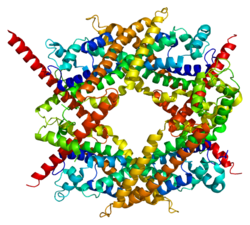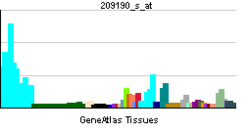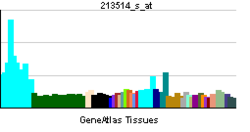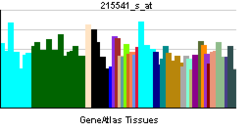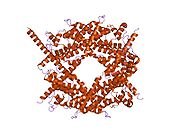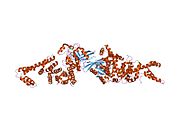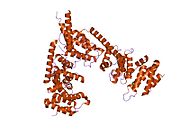- DIAPH1
-
Protein diaphanous homolog 1 is a protein that in humans is encoded by the DIAPH1 gene.[1][2][3]
Contents
Function
This gene is a homolog of the Drosophila diaphanous gene and belongs to the protein family of the formins, characterized by the formin homology 2 (FH2) domain. It has been linked to autosomal dominant, fully penetrant, nonsyndromic sensorineural progressive low-frequency hearing loss. Actin polymerization involves proteins known to interact with diaphanous protein in Drosophila and mouse. It has therefore been speculated that this gene may have a role in the regulation of actin polymerization in hair cells of the inner ear. Alternatively spliced transcript variants encoding distinct isoforms have been found for this gene.[3]
Interactions
DIAPH1 has been shown to interact with RHOA.[4]
See also
- mDia1
References
- ^ Lynch ED, Lee MK, Morrow JE, Welcsh PL, Leon PE, King MC (Dec 1997). "Nonsyndromic deafness DFNA1 associated with mutation of a human homolog of the Drosophila gene diaphanous". Science 278 (5341): 1315–8. doi:10.1126/science.278.5341.1315. PMID 9360932.
- ^ Leon PE, Raventos H, Lynch E, Morrow J, King MC (Jun 1992). "The gene for an inherited form of deafness maps to chromosome 5q31". Proc Natl Acad Sci U S A 89 (11): 5181–4. doi:10.1073/pnas.89.11.5181. PMC 49253. PMID 1350680. http://www.pubmedcentral.nih.gov/articlerender.fcgi?tool=pmcentrez&artid=49253.
- ^ a b "Entrez Gene: DIAPH1 diaphanous homolog 1 (Drosophila)". http://www.ncbi.nlm.nih.gov/sites/entrez?Db=gene&Cmd=ShowDetailView&TermToSearch=1729.
- ^ Riento, Kirsi; Guasch Rosa M, Garg Ritu, Jin Boquan, Ridley Anne J (Jun. 2003). "RhoE binds to ROCK I and inhibits downstream signaling". Mol. Cell. Biol. (United States) 23 (12): 4219–29. doi:10.1128/MCB.23.12.4219-4229.2003. ISSN 0270-7306. PMC 156133. PMID 12773565. http://www.pubmedcentral.nih.gov/articlerender.fcgi?tool=pmcentrez&artid=156133.
Further reading
- Reinhard M, Giehl K, Abel K, et al. (1995). "The proline-rich focal adhesion and microfilament protein VASP is a ligand for profilins.". EMBO J. 14 (8): 1583–9. PMC 398250. PMID 7737110. http://www.pubmedcentral.nih.gov/articlerender.fcgi?tool=pmcentrez&artid=398250.
- Andersson B, Wentland MA, Ricafrente JY, et al. (1996). "A "double adaptor" method for improved shotgun library construction.". Anal. Biochem. 236 (1): 107–13. doi:10.1006/abio.1996.0138. PMID 8619474.
- Yu W, Andersson B, Worley KC, et al. (1997). "Large-scale concatenation cDNA sequencing.". Genome Res. 7 (4): 353–8. doi:10.1101/gr.7.4.353. PMC 139146. PMID 9110174. http://www.pubmedcentral.nih.gov/articlerender.fcgi?tool=pmcentrez&artid=139146.
- Fujiwara T, Mammoto A, Kim Y, Takai Y (2000). "Rho small G-protein-dependent binding of mDia to an Src homology 3 domain-containing IRSp53/BAIAP2.". Biochem. Biophys. Res. Commun. 271 (3): 626–9. doi:10.1006/bbrc.2000.2671. PMID 10814512.
- Kato T, Watanabe N, Morishima Y, et al. (2001). "Localization of a mammalian homolog of diaphanous, mDia1, to the mitotic spindle in HeLa cells.". J. Cell. Sci. 114 (Pt 4): 775–84. PMID 11171383.
- Westendorf JJ (2002). "The formin/diaphanous-related protein, FHOS, interacts with Rac1 and activates transcription from the serum response element.". J. Biol. Chem. 276 (49): 46453–9. doi:10.1074/jbc.M105162200. PMID 11590143.
- Sahai E, Marshall CJ (2002). "ROCK and Dia have opposing effects on adherens junctions downstream of Rho.". Nat. Cell Biol. 4 (6): 408–15. doi:10.1038/ncb796. PMID 11992112.
- Montagnoli A, Bosotti R, Villa F, et al. (2002). "Drf1, a novel regulatory subunit for human Cdc7 kinase.". EMBO J. 21 (12): 3171–81. doi:10.1093/emboj/cdf290. PMC 126049. PMID 12065429. http://www.pubmedcentral.nih.gov/articlerender.fcgi?tool=pmcentrez&artid=126049.
- Tominaga T, Meng W, Togashi K, et al. (2003). "The Rho GTPase effector protein, mDia, inhibits the DNA binding ability of the transcription factor Pax6 and changes the pattern of neurite extension in cerebellar granule cells through its binding to Pax6.". J. Biol. Chem. 277 (49): 47686–91. doi:10.1074/jbc.M207539200. PMID 12324464.
- Strausberg RL, Feingold EA, Grouse LH, et al. (2003). "Generation and initial analysis of more than 15,000 full-length human and mouse cDNA sequences.". Proc. Natl. Acad. Sci. U.S.A. 99 (26): 16899–903. doi:10.1073/pnas.242603899. PMC 139241. PMID 12477932. http://www.pubmedcentral.nih.gov/articlerender.fcgi?tool=pmcentrez&artid=139241.
- Gevaert K, Goethals M, Martens L, et al. (2004). "Exploring proteomes and analyzing protein processing by mass spectrometric identification of sorted N-terminal peptides.". Nat. Biotechnol. 21 (5): 566–9. doi:10.1038/nbt810. PMID 12665801.
- Vicente-Manzanares M, Rey M, Pérez-Martínez M, et al. (2003). "The RhoA effector mDia is induced during T cell activation and regulates actin polymerization and cell migration in T lymphocytes.". J. Immunol. 171 (2): 1023–34. PMID 12847276.
- Stüven T, Hartmann E, Görlich D (2003). "Exportin 6: a novel nuclear export receptor that is specific for profilin.actin complexes.". EMBO J. 22 (21): 5928–40. doi:10.1093/emboj/cdg565. PMC 275422. PMID 14592989. http://www.pubmedcentral.nih.gov/articlerender.fcgi?tool=pmcentrez&artid=275422.
- Ota T, Suzuki Y, Nishikawa T, et al. (2004). "Complete sequencing and characterization of 21,243 full-length human cDNAs.". Nat. Genet. 36 (1): 40–5. doi:10.1038/ng1285. PMID 14702039.
- Yasuda S, Oceguera-Yanez F, Kato T, et al. (2004). "Cdc42 and mDia3 regulate microtubule attachment to kinetochores.". Nature 428 (6984): 767–71. doi:10.1038/nature02452. PMID 15085137.
- Mammoto A, Huang S, Moore K, et al. (2004). "Role of RhoA, mDia, and ROCK in cell shape-dependent control of the Skp2-p27kip1 pathway and the G1/S transition.". J. Biol. Chem. 279 (25): 26323–30. doi:10.1074/jbc.M402725200. PMID 15096506.
- Rundle DR, Gorbsky G, Tsiokas L (2004). "PKD2 interacts and co-localizes with mDia1 to mitotic spindles of dividing cells: role of mDia1 IN PKD2 localization to mitotic spindles.". J. Biol. Chem. 279 (28): 29728–39. doi:10.1074/jbc.M400544200. PMID 15123714.
- Carreira S, Goodall J, Denat L, et al. (2007). "Mitf regulation of Dia1 controls melanoma proliferation and invasiveness.". Genes Dev. 20 (24): 3426–39. doi:10.1101/gad.406406. PMC 1698449. PMID 17182868. http://www.pubmedcentral.nih.gov/articlerender.fcgi?tool=pmcentrez&artid=1698449.
External links
- DIAPH1 Info with links in the Cell Migration Gateway
PDB gallery 1v9d: Crystal structure of the core FH2 domain of mouse mDia11z2c: Crystal structure of mDIA1 GBD-FH3 in complex with RhoC-GMPPNP2bap: Crystal structure of the N-terminal mDia1 Armadillo Repeat Region and Dimerisation Domain in complex with the mDia1 autoregulatory domain (DAD)2bnx: CRYSTAL STRUCTURE OF THE DIMERIC REGULATORY DOMAIN OF MOUSE DIAPHANEOUS-RELATED FORMIN (DRF), MDIA12f31: Crystal structure of the autoinhibitory switch in Formin mDia1; the DID/DAD complexCategories:- Human proteins
- Chromosome 5 gene stubs
Wikimedia Foundation. 2010.

